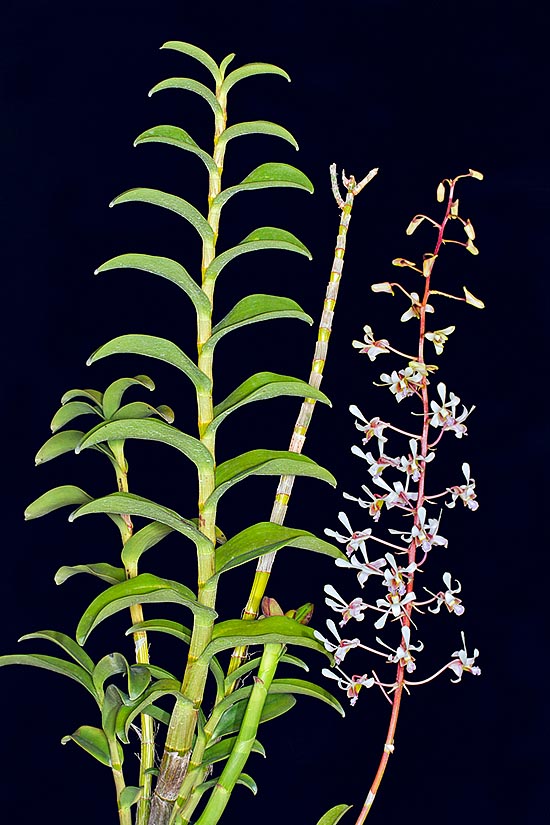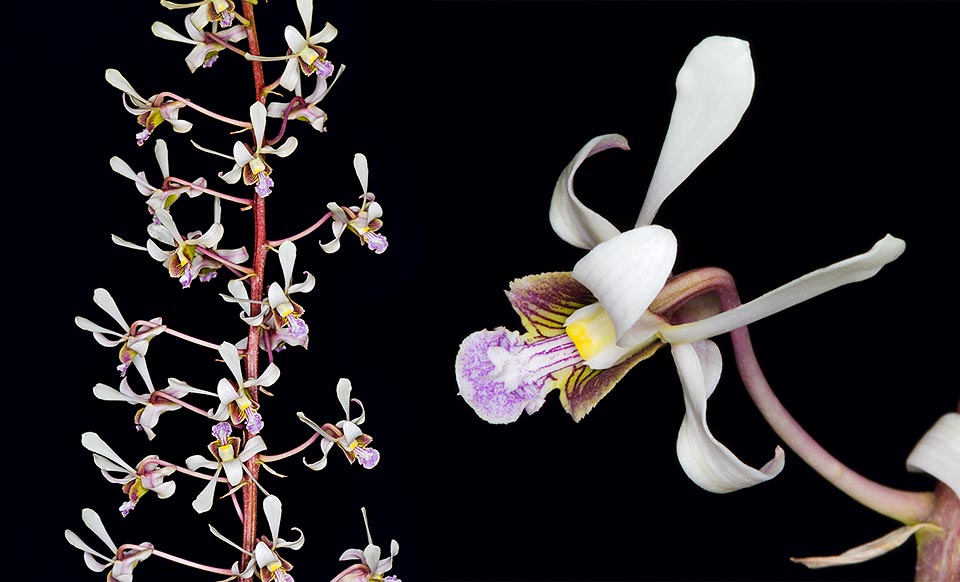Family : Orchidaceae

Text © Pietro Puccio

English translation by Mario Beltramini

Dendrobium lineale is a New Guinea epiphytic or lithophytic species © Giuseppe Mazza
The name of the genus is the combination of the Greek substantives “δένδρον” (dendron) = tree and “βίος” (bios) = life, with reference to the numerous species of the genus living on the trees; the name of the species is the Latin adjective “linealis, a, um” = having lines, with reference to the numerous lines on the labellum.
Common names: Morobe shower orchid (English).
The Dendrobium lineale Rolfe (1889) is an epiphytic or lithophytic species, rather variable for colour of the flowers, with erect cylindrical pseudobulbs thinned towards the apex, usually 0,6-1 m tall, but which, in the old specimens, can reach the 2 m, and of 1,5-3 cm of diameter, with persistent alternate, distichous, oblong-lanceolate, coriaceous, rigid, intense green leaves.
Racemose inflorescences from the upper nodes of the ripe pseudobulbs, erect or curved, up to about 80 cm long, carrying numerous flowers of 4-6 cm of diameter, generally white or shaded of pink, yellow, violet or purple with labellum striated of purple.
Linear sepals with pointed and retroflexed apex, the lateral sepals, merged at the base of the column, form a sort of a spur (mentum) about 1 cm long.
Erect and partially twisted spatulate petals, trilobed labellum with lateral lobes erect on the sides of the column and obovate median lobe with undulated margins and pointed apex.
It reproduces by seed, in vitro, and division, to be done by the vegetative restart, with each section provided of at least 3-4 pseudobulbs.
Floriferous species, quite rare in cultivation, with perfumed long lasting flowers, up to 2 months, requires high luminosity, also some hours of direct sunlight, medium-high temperatures in summer, 22-32 °C, averagely cooler in winter, with minimum ones not below the 15 °C, high humidity, 70-80%, and constant ventilation.
The waterings must be regular and abundant all over it vegetative period, avoiding stagnations at the apex of the new vegetations, particularly sensitive to the rottenness, slightly more spaced in winter till the vegetative restart. For the waterings and nebulisations is to be used rain water, from reverse osmosis or demineralised; the fertilizations, duly distributed in way to avoid salts accumulation, are to be done during the vegetative period preferably with hydrosoluble balanced products, with microelements, at ¼ of the dosage suggested on the package.

Rare species in cultivation, with variably coloured inflorescences, even 80 cm long and 4-6 cm perfumed flowers which may last 2 months © Giuseppe Mazza
Synonyms: Dendrobium veratrifolium Lindl. (1843); Callista veratrifolia Kuntze (1891); Dendrobium cogniauxianum Kraenzl. (1891); Dendrobium augustae-victoriae Kraenzl. (1894); Dendrobium imperatrix Kraenzl. (1895); Dendrobium grantii C.T.White (1940). Dendrobium veratroides Bakh.f. (1963); Durabaculum veratrifolium M.A.Clem. & D.L.Jones (2002).
→ For general notions about ORCHIDACEAE please click here.
